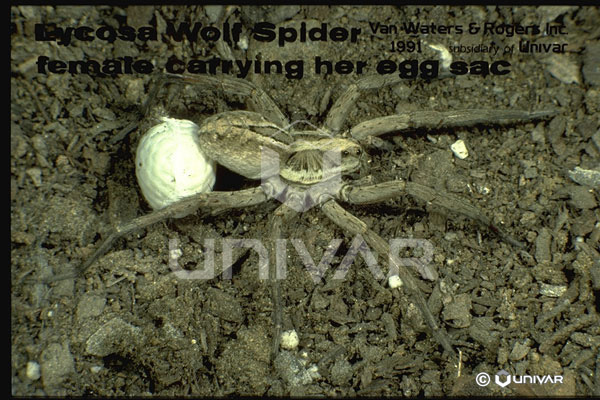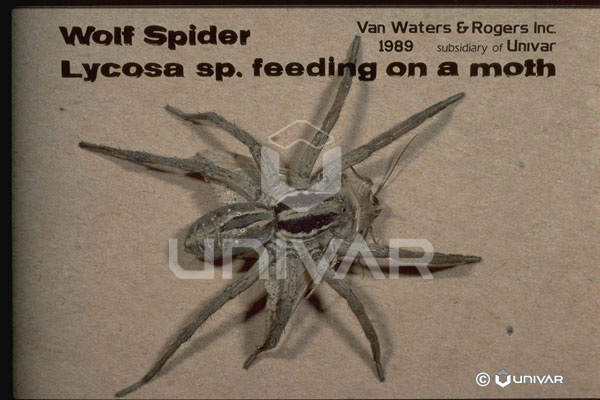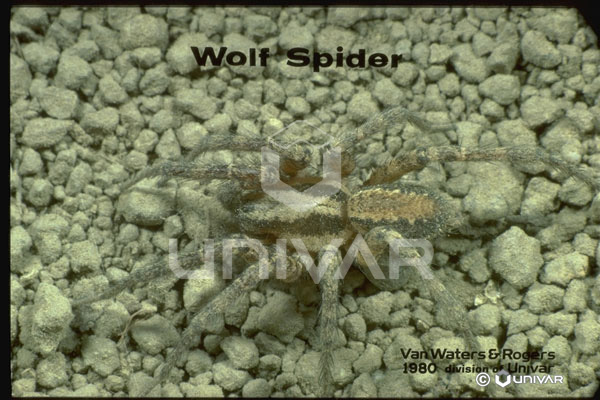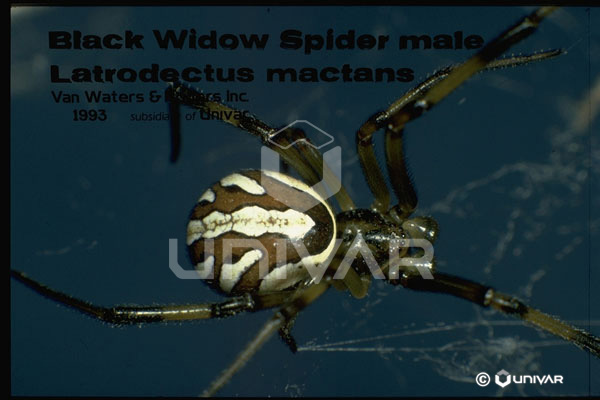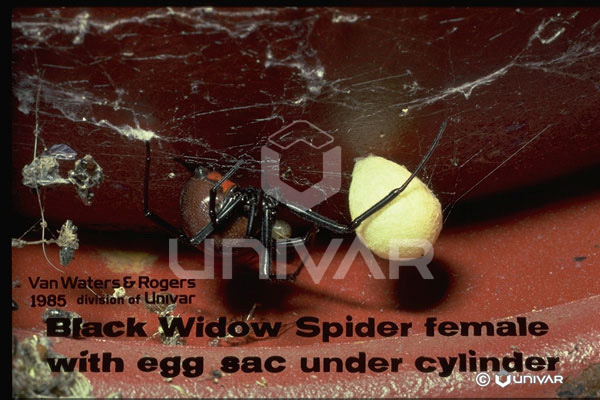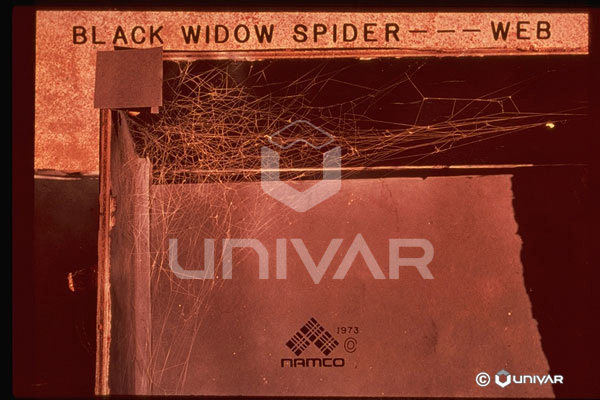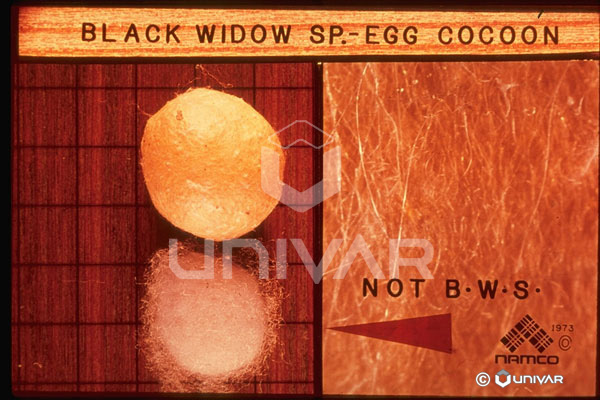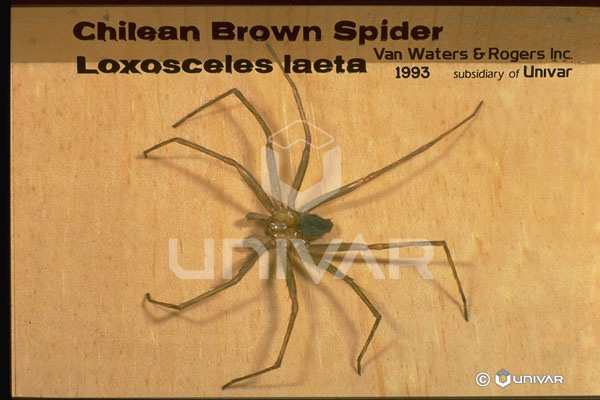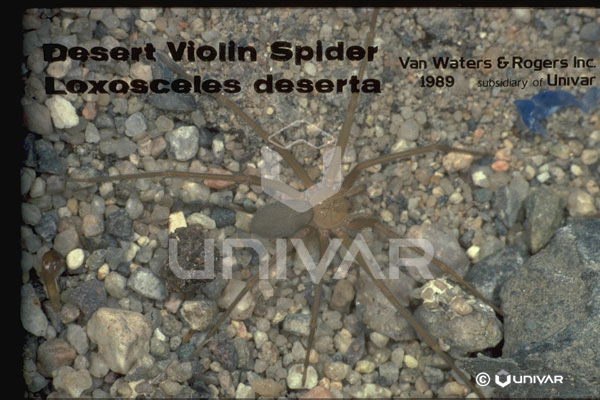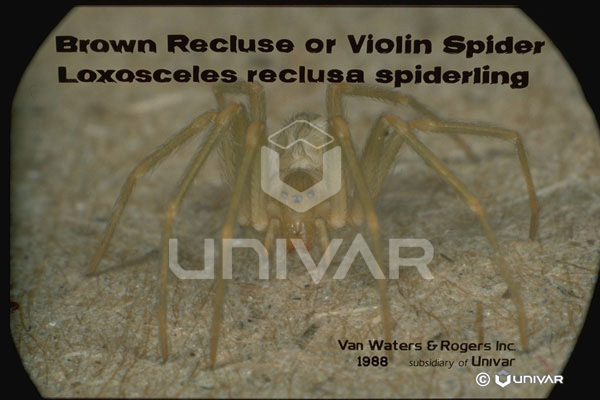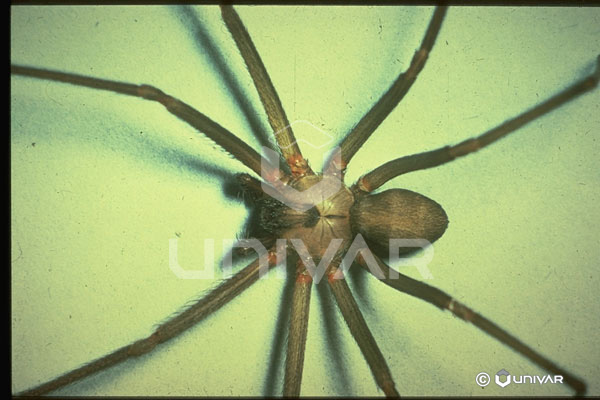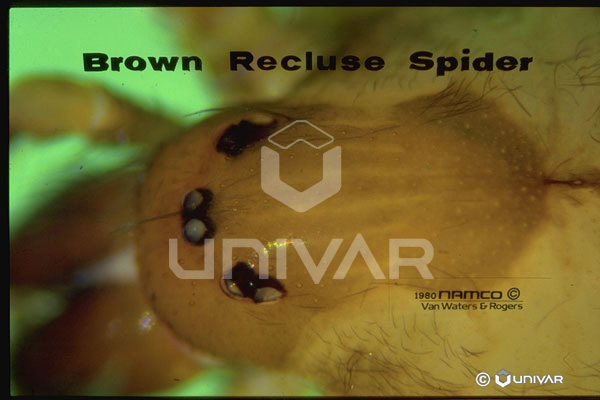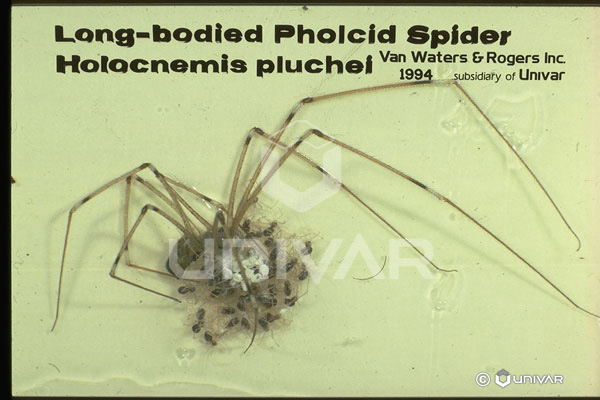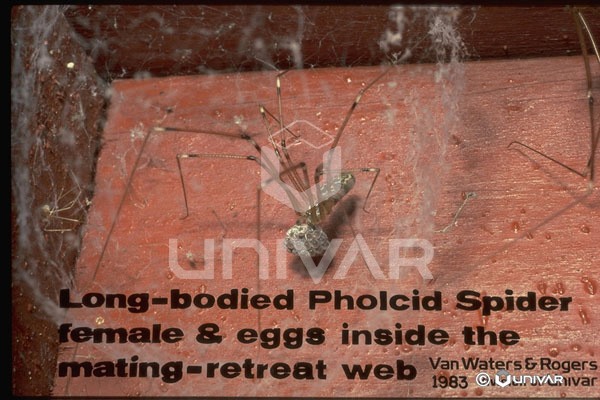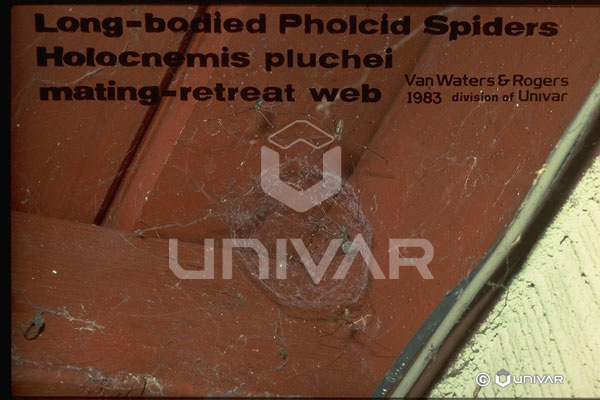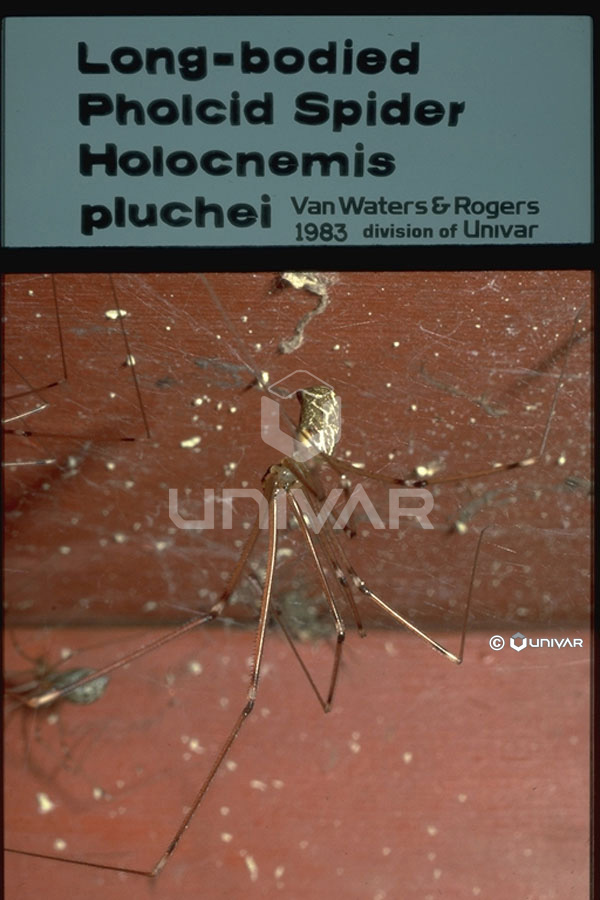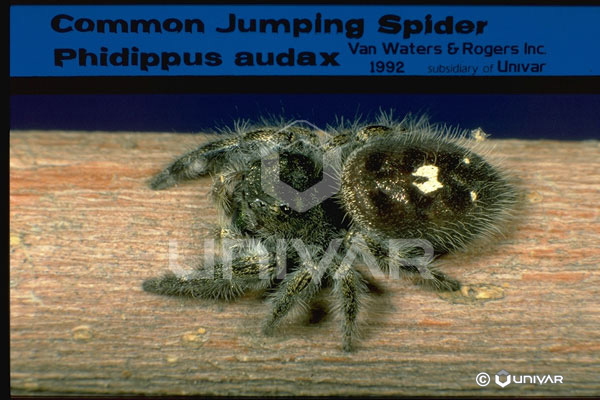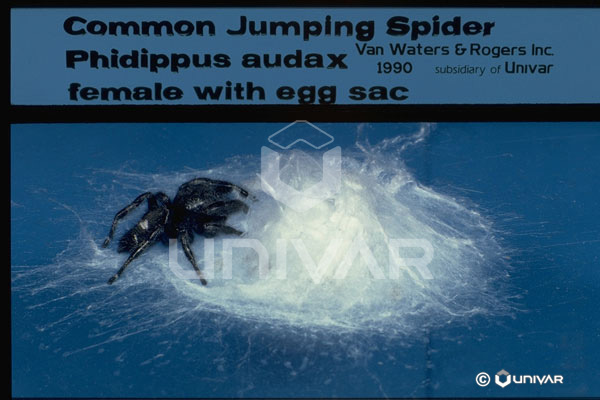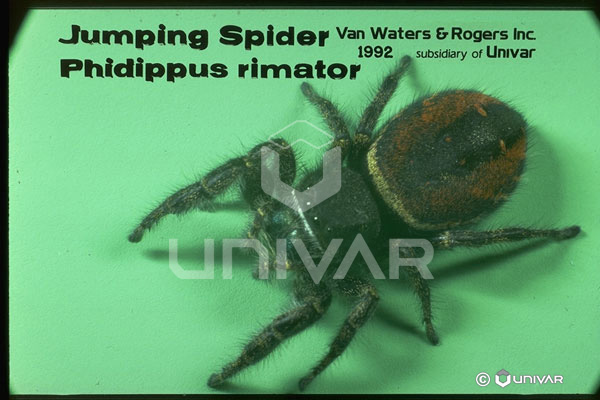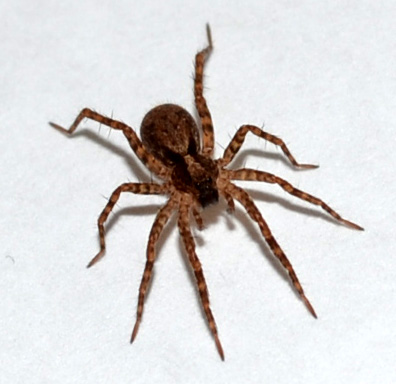
WOLF SPIDER
Common Name: Spider – Wolf spider
Latin Name: Lycosa
Common Family Name: Wolf spiders
Latin Family Name: Lycosidae
Other Names:
Origin: There are over 200 species of wolf spiders found north of Mexico, and these often are the most common spiders in cold climates of high mountains or far northern regions.
Biology: Wolf spiders are hunters, and use their silk only for lining a nest and for covering their eggs. The females create the tough egg sac and then carry it attached to the tip of the abdomen. Once the eggs hatch the mother then cuts a slit in the sac to allow her young to emerge, and they then climb onto her abdomen to be carried around for up to 2 weeks. Some species of wolf spiders may have leg spans of 4 inches or more and they are very mobile, very fast, and very aggressive when threatened. They are capable of biting humans but the venom is not considered dangerous, but their aggressive behavior makes wolf spiders some of the most feared by people. Smaller species may even “run” across the water of a swimming pool, suspended on the surface tension of the water. Retreats for the spiders are holes in the soil, under debris on the ground, or within wood piles. They commonly enter structures and can be found running across floors or walls as they search for food.
Identification: Wolf spiders vary in size from small species with only ½ inch leg spans to large ones whose legs may stretch out 5 inches. In general, they are long-legged and covered with short hairs, gray to brown to dark brown, and with several darker stripes running longitudinally on the cephalothorax. These body regions are somewhat pear-shaped, with the front much narrower than the back and with the front, when viewed from the side, sitting higher than the back. However, the eyes are distinctive, with 8 ocelli arranged in the following manner. The “face” area is usually perpendicular, and the hind pair of ocelli sit at the top of the face, a large pair of ocelli sit facing directly forward, and 4 smaller ocelli are in an arc below this enlarged pair.
Characteristics Important in Control: There is little reason to kill these beneficial spiders, and those found inside should be captured alive and removed to the outside, where their activity as predators benefits the landscape. General cleanup of unnecessary debris outside will reduce harborage sites, and cleanup of clutter in garages or storage areas will reduce the number of spiders living on the interior. If invading spiders become a problem they can be prevented with an application of a residual pyrethroid insecticide around the building exterior and in likely pathways along walls on the inside.
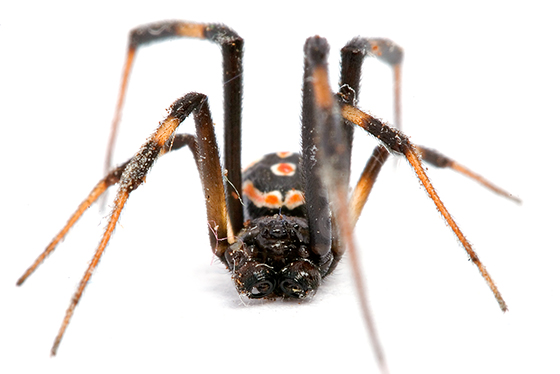
BLACK WIDOW
Common Name: Spider – Black widow
Latin Name: Latrodectus
Common Family Name: Comb-footed spiders
Latin Family Name: Theridiidae
Origin: Five species of these native spiders occur in North America, being found in all states and southern Canada. Other species may be found worldwide.
Biology: Black widow spiders are considered one of the most dangerous spiders in the U.S. They are one of the few spiders capable of biting humans that inject a neurotoxin, and the effect of the bite can be serious and potentially fatal. Only females bite humans, but both males and females construct webs to capture other prey, primarily flying insects. Males also enter a female’s web for mating, and if the female is not receptive the male may be eaten. The life span of black widow females averages around 180 days as an adult, taking about 3 months to reach maturity. Males mature in about 70 days and live only about 30 days after that. The female may produce up to 9 egg sacs with about 350 eggs per sac on average. She will be most aggressive and defensive of her webbing while she is guarding these eggs, as well as being more hungry following egg production. The new spiderlings emerge from the sac and remain near it for a day or two, but then they undergo “ballooning” to disperse, creating long silk strands that are carried away by the wind. Black widows are generally reclusive spiders that create their webs in areas of inactivity. The web is made of very sticky and extremely strong silk, and it has a very haphazard appearance without the symmetry of some other spiders.
Identification: Females are the most recognized spider in North America, with their shiny black body, long thin legs, large oval abdomen, and red “hourglass” pattern on the underside of the abdomen. This hourglass pattern may not always be there. Males also have the same pattern, but it is white, and their body color is mottled brown and white. Immature spiders begin very light-colored and progress to the adult color in stages as they pass through their instars, gradually becoming more black if they are females. The female tends to hang upside down in her web due to the weight of the abdomen. Eggs sacs of black widows are about ½ inch in diameter and are smooth surfaced. The eyes of comb-footed spiders are typically a total of eight eyes arranged in two rows of four eyes, one row above the other and with the outside eyes so close together that they touch each other.
Characteristics Important in Control: Elimination of unnecessary debris in storage or on the exterior will reduce harborage sites, including lumber or firewood piles, boards or other materials on the ground, and yard debris. Materials stored in garages or other interior storage areas can be kept off the floor and in a condition that allows access to the areas behind them. The individual spider inside may be eliminated by vacuuming, and the webbing is then removed with a sweep. For chemical control the pyrethroid insecticides are excellent, giving quick knockdown and kill and a lengthy residual.
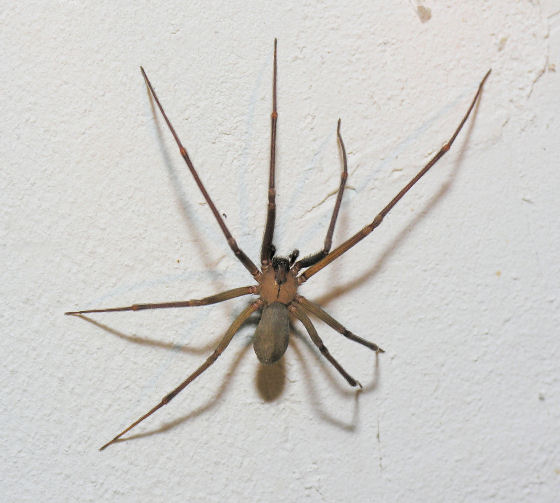
BROWN RECLUSE
Common Name: Spider – Violin spider
Latin Name: Loxosceles
Common Family Name: Brown spiders
Latin Family Name: Loxoscelidae
Other Names: Brown recluse spider, fiddleback spider
Origin: 11 species of Loxosceles are native to the United States, and at least one imported species is found in the southwest. The Brown Recluse, L. reclusa, has the widest range, from a small area of western Florida to Texas and north to Iowa. It has been found sporadically as a transient in other states. The other 10 native species are found in the southwest from Texas to California.
Biology: The Brown Recluse, Loxosceles reclusa, has a reputation that far exceeds reality. It is a hunting spider that uses its web only for lining its retreat and for covering its eggs. It is very capable of biting humans, and the venom is a cytotoxic venom that causes tissue death at the site of the bite, possibly leading to a large, infected, and lingering wound. However, experts believe that most skin infections blamed on this spider’s bite are bacterial infections, particularly in states with very high reported bites but very low confirmed presence of the spider. The Brown Recluse lives commonly in structures, hiding with clothing, behind furnishings, or in attics and wall voids. Young spiders take about one year to mature and the adults live about one year more. They prefer to remain in areas of low activity and are not aggressive, biting only when provoked to do so by becoming trapped and threatened with harm.
Identification: These are light to dark brown spiders with very long legs and short hairs covering the legs and body segments. On the top of the cephalothorax there usually will be a darker pattern that strongly resembles a violin, giving this genus its common names of “violin” or “fiddleback”. However, many other spiders also have this vague pattern, and identification cannot be made based only on this character. The eyes of Loxosceles are very distinctive for the genus. There are 6 eyes arranged as 3 pairs in an arc across the front of the cephalothorax which can be seen easily with low magnification.
Characteristics Important in Control: General cleanup of unnecessary debris outside will reduce harborage sites, and cleanup of clutter in garages or storage areas will reduce the number of spiders living on the interior. If invading spiders become a problem they can be prevented with an application of a residual pyrethroid insecticide around the building exterior and in likely pathways along walls on the inside. The use of glue traps can confirm the presence of the spiders, placed in attics or along wall-floor junctions. Dust formulations can be injected into walls or other voids the spiders may inhabit. Since structures can be re-infested from surrounding areas the habitat of this spider should be pushed as far away from the structure as possible. Heavy vegetation cover on the ground should be kept away from the structure, and all debris and materials on the soil that do not have to be there should be eliminated. Trees and shrubs that grow near the structure should be physically separated by pruning, and all cracks or other openings to the structure that can be repaired should be permanently sealed.
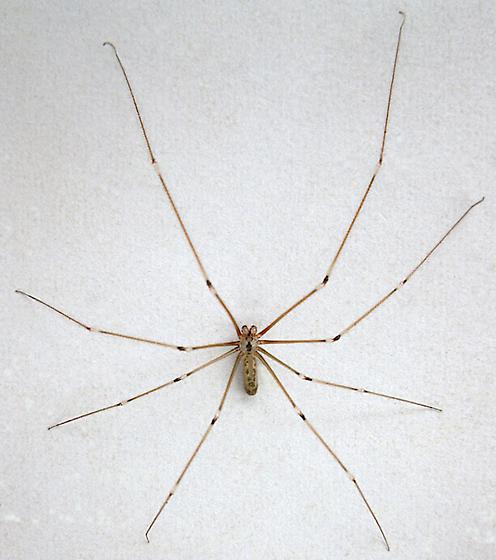
CELLAR SPIDER
Common Name: Spider – Cellar spider
Latin Name: Pholcus phalangioides
Common Family Name: Long-legged spiders
Latin Family Name: Pholcidae
Other Names: Long-bodied cellar spider, short-bodied cellar spider, daddy-long legs spider
Origin: Several dozen species of Pholcids are native to North America, with the three species listed above the most common to be found in and on structures.
Biology: The cellar spiders are often called “Daddy Long-legs” due to their very long, thin legs. However, the true Daddy Long-legs is another animal entirely, called the Harvestman. The cellar spiders are incapable of biting humans and are harmless to us and our pets. Their primary crime is the messiness of their webs, which are thin and flimsy but tend to gather dust and floating debris, as well as the remains of the insects the spiders have fed on. Webs typically appear under the eaves of roofs, around porch lights, within garages, and indoors around windows where the light may draw small insects that the spiders feed on. Their long legs make them very clumsy when attempting to walk. They hang upside down on their webs, and when disturbed they will begin to shake and bounce the web noticeably, or they may drop off the web and run to hide. These spiders have been known to feed on black widow spiders. The female creates an egg mass of about a dozen eggs and holds it in her jaws until the eggs hatch.
Identification: Cellar spiders are easily identified by their extraordinarily long and thin legs, which are attached to their elongated and thin body. The color is a yellowish brown and the legs may be as long as 2 inches. There may be either 6 or 8 eyes, depending on the species, and the outer 3 eyes on either side of the head are arranged in a close triangle.
Characteristics Important in Control: Sweeping of webs to remove them is an important step in cellar spider control, as these spiders do not reuse their silk, and the webs continue to accumulate. Sweeping is not likely to kill the spiders, but pyrethroid insecticides provide excellent knockdown and control. Reduction of other insects in and around a home will reduce the food available to the spiders, and removal of debris and lumber piles will help to reduce harborage sites. Reduction of outdoor lighting or changing white light bulbs to yellow will help to attract fewer night-flying insects and thus reduce the spider populations.
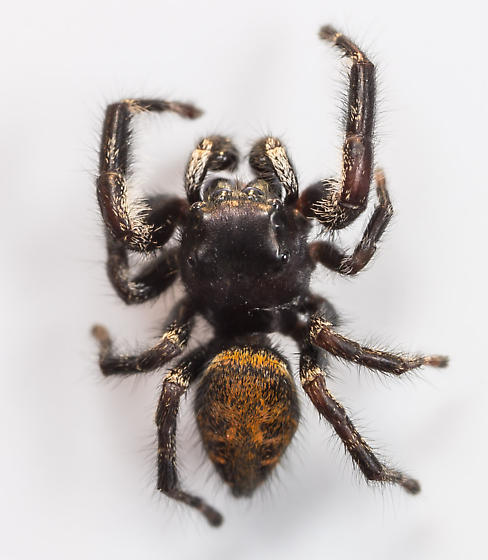
JUMPING SPIDER
Common Name: Spider – Jumping spider
Latin Name: Phidippus
Common Family Name: Jumping spiders
Latin Family Name: Salticidae
Other Names: Over 300 species of jumping spiders, in at least 40 genera, occur in North America.
Origin: These beneficial spiders are native to the United States and Canada.
Biology: Jumping spiders are hunters, using their silk to line their abode, covering their eggs, and as a “drag line” behind them as they walk about. While many of them are capable of biting humans if they are treated roughly or trapped in clothing, jumping spiders generally are harmless, with venom of no particular consequence to people or pets. They are medium-sized, very colorful, and very active spiders, found wandering over walls or floors as they hunt for and feed on other arthropods we consider pests. For spiders they have excellent eyesight, seeing well from up to 18 inches with their greatly enlarged eyes that face directly to the front. These are primarily diurnal spiders, needing the light to see their prey, and in addition to their stealthy movements forward and backward, they also can leap up to 20 times their body length to escape a threat. There are 8 ocelli jumping spiders, with 2 pairs of small eyes on the sides of the top of the cephalothorax, and 2 pairs facing front on the flattened “face” of the spider, often with the center two eyes tremendously enlarged.
Identification: While there is some diversity in their appearance, due to a large number of species, jumping spiders, in general, are stout, hairy spiders with short, strong legs. The top of the abdomen often has colorful hairs of red, orange, yellow, or white, and some males may have brilliant iridescent green or blue chelicerae (the jaws). It is the enlarged middle front pair of eyes that distinguishes these interesting spiders.
Characteristics Important in Control: There is no reason to kill jumping spiders, their benefits as predators far exceed any minimal hazard that someone may be bitten. If they occur indoors they should be captured and released outside. Prevention of flies and other insects indoors will reduce food availability to the spiders, and cleanup of debris outside will reduce potential harborage sites.
